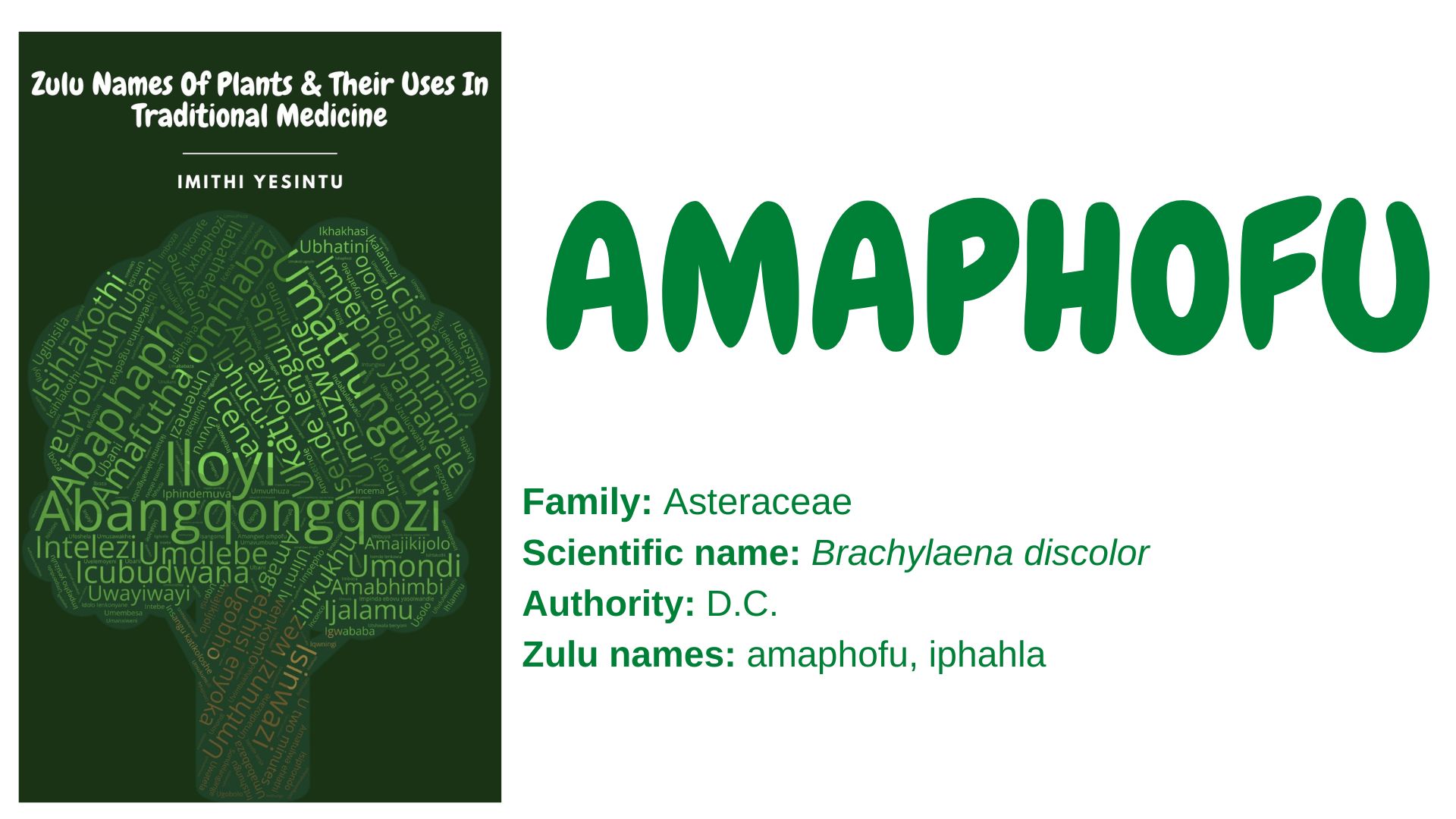Family: Asteraceae
Scientific name: Brachylaena discolor
Authority: D.C.
Synonym: Brachylaena natalensis Sch.Bip.
Zulu names: amaphofu, iphahla
Other names: coastal silver oak (English) kusvaalbos (Afrikaans)
Plant description: B. discolor is an evergreen small tree (or shrub) with dark-green and silver leaves, white and creamy flowers that are rich in nectar, small achene fruits containing tiny seeds covered in tufts of yellowish bristly hairs, and strong wood. The tree is widely distributed along KwaZulu Natal coast line and woodland habitats.
Uses:
- The ash from charring the plant is used to produce soap that is used to treat dermatological conditions.
- The leaves are used to treat diabetes.
- The leaves are used to make a paste that is applied topically to treat skin infections.
- The roots are used to make a decoction to treat infertility.
- The plant is used to treat gastrointestinal bleeding.
- The plant is used to treat chest pain and tuberculosis (TB).
- The plant is used to treat kidney diseases.
- The plant is used to treat intestinal parasites.
- The roots are used to treat hysteria in girls.
- The wood is used to make carving, construction, wooden tools, and knobkerries.
- The tree is cultivated as a garden ornamental that is used as a hedge, windbreak, and to stabilize dunes.
Safety precaution:
Using traditional medicine responsibly can enhance your overall health and well-being. Misuse and abuse can lead to complications. You can inquire about the correct use of traditional medicine from a knowledgeable herbalist and practitioner. You can also visit imithiyesintu.co.za or email: info@imithiyesintu.co.za to learn more about traditional medicine
References and further reading:
- Beentje, H., 2000. The genus Brachylaena (Compositae: Mutisieae). Kew Bulletin, pp. 1– 41.
- Boon, R., 2010. Pooley’s Trees of eastern South Africa. South Africa: Flora and Fauna Publications Trust.
- Bryant, A.T., 1909. Zulu medicine and medicine-men. Annals of the Natal Museum 2, pp.1–103.
- Coates Palgrave, K., 2002. Trees of Southern Africa. Struik. Cape Town, South Africa, pp. 1-959.
- Deutschländer, M. S., 2010. Isolation and identification of a novel anti-diabetic compound from Euclea undulata Thunb. PhD thesis, Plant Science, University of Pretoria.
- Deutschländer, M., Lall, N. and Van De Venter, M., 2009. Plant species used in the treatment of diabetes by South African traditional healers: An inventory. Pharmaceutical Biology, 47 (4), pp.348–365.
- De Wet, H., Nciki, S. and van Vuuren, S.F., 2013. Medicinal plants used for the treatment of various skin disorders by a rural community in northern Maputaland, South Africa. Journal of Ethnobiology and Ethnomedicine, 9(1), pp.1-10.
- Friede, H.M., 1978. Methods of traditional fire‐making in pre‐industrial South Africa. African Studies, 37(2), pp.227-234.
- Herman, P., 1998. Asteraceae: A note on the Brachylaena discolor complex. Bothalia, 28 (1), pp.42–45.
- Jodamus, N., 2003. Brachylaena discolor. South African National Biodiversity Institute. Available at: http://www.plantzafrica.com/plantab/brachylaendiscol.html (Accessed: 19 August 2023).
- Masondo, N.A., Stafford, G.I., Aremu, A.O. and Makunga, N.P., 2019. Acetylcholinesterase inhibitors from southern African plants: An overview of ethnobotanical, pharmacological potential and phytochemical research including and beyond Alzheimer’s disease treatment. South African journal of botany, 120, pp.39-64.
- Mellem, J.J., 2013. Isolation and characterization of the leaves of Brachylaena discolor extract as an anti-diabetic agent (Doctoral dissertation, Durban University of Technology).
- Mtshali, S.N., 2019. Identification of triterpenoids in Brachylaena discolor DC, a plant with antidiabetic activity (Doctoral dissertation).
- Nciki, S., Vuuren, S., van Eyk, A. and de Wet, H., 2016. Plants used to treat skin diseases in northern Maputaland, South Africa: antimicrobial activity and in vitro permeability studies. Pharmaceutical Biology 54 (11), pp. 2420–2436.
- Semenya, S.S., Maroyi, A., Potgieter, M.J. and Erasmus, L.J.C., 2013. Herbal medicines used by Bapedi traditional healers to treat reproductive ailments in the Limpopo Province, South Africa. African Journal of Traditional, Complementary and Alternative medicines, 10(2), pp.331-339.
You Can Order Your Copy Of The Book By Emailing: info@imithiyesintu.co.za
Feel Free To Add Other Uses Of This Plant In The Comment Section Below:

